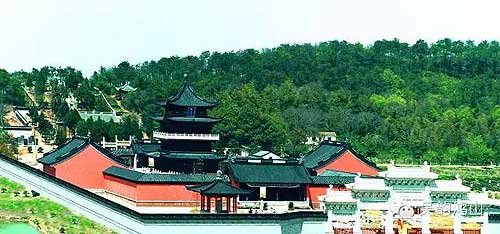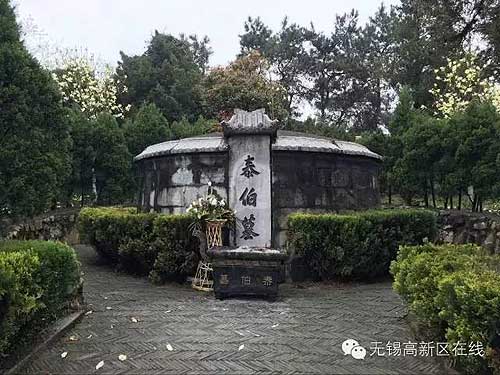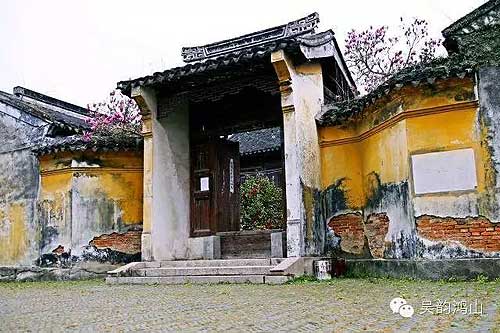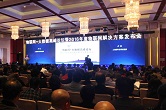Home > News
Tomb Sweeping Day, excellent time to visit Hongshan Hill
(chinadaily.com.cn)
Updated: 2016-04-06
During Qinming Festival, Hongshan Hill in southwest Wuxi's Hongshan town welcomes visitors to pay tribute to two famous historical figures, Taibo of Wu and Liang Hong.
Also known as Tomb Sweeping Day, Qingming Festival offers a chance for Chinese people to visit the tombs of the deceased loved ones and pay tribute to their ancestors. The occasion forms an important part of Chinese culture, which has always placed an important emphasis on respecting the ancestors. The festival extends for 10 days either side of Tomb Sweeping Day, which fell on April 4 this year.
The Hongshan town government has held a memorial service for Taibo - revered as the founder of the State of Wu and the ancestor of people surnamed Wu - on April 10 for the last ten years. To mark the tenth straight memorial, they invited the local media to visit the mausoleum and shrine of Taibo this year. The mausoleum was declared a national cultural relic site in 2006 and is located in the southern foothill of Hongshan Hill.
 |
|
The mausoleum of Taibo located in the southern foothill of the Hongshan Hill in Hongshan town, Wuxi city, Jiangsu province. [Photo from WeChat account wyhs000] |
In the square in front of the mausoleum is a statue of Taibo in a sitting pose. Inside the gate are rows of buildings that were constructed through the years under the guidance of various patronages. The buildings are positioned from south to north and include a pathway lined by pine and cypress trees and stone sculptures, a four-story tower that betokens admiration for Taibo and a 20-acre pool in the shape of a crescent moon. Taibo's tomb can also be found there; it is comprised of a two-meter-high and three-meter-wide mound.
 |
| The tomb of Taibo. [Photo from Wuxi New District's WeChat account xinwu_wx] |
Couplets and plaques found at the site praise the nobility and humility of Taibo. He left his native land in the northwest of China for Meili in the lands of Wu (located in nowadays Wuxi) so his father could pass the reins of power to his younger brother, Jili. Jili's son later went on to found the Zhou Dynasty (circa 11th century to 256 BC). The great historian Sima Qian ranked the Wu clan top among all aristocratic families in the Records of the Grand Historian.
East of the moon-shaped pool is a yard of steles that were recently erected by members of the Wu clan, now scattered across the world.
Outside the yard is a road leading up to the ridge of the Hongshan Hill. Walking along the rolling ridge to the east, visitors can enjoy the fresh air and the tranquility there. A trail diverges from the road along the ridge and leads to the tomb of Liang Hong, a hermit and poet of the Eastern Han Dynasty (AD 25-220) who lived his final days in the lands of Wu. Liang was known to be a learned scholar and a moral person. He was buried together with his wife Meng Guang, a virtuous woman. The headstone at the grave was erected in 1943 by a descendant called Liang Xieyong.
Farther to the east side is a road leading down to the foothill. On the way back to the mausoleum, visitors will pass Hongyin House, which is said to be the former residence of Liang. The name plaque over the gate was written by Wen Zhengming, a renowned calligrapher from Ming Dynasty (1368-1644). The mansion contains four rows of buildings, including an old well in the courtyard named Hongquan.
At the back row of the house is Xiangbao Hall, which acted as Liang's study. Liang's work entitled Wuyige can be seen inside the study. The poem was recorded in the biographical history book Book of Later Han by Fan Ye, a historian from the Liu Song Dynasty (420-479). It ridicules Emperor Zhangdi's extravagance lifestyle in spite of the hardships of civilians at the time.
 |
| The front door of the Hongyin Hall.[Photo from WeChat account wyhs000] |
Location: north of the intersection of Zhixian Road and Zhide Street
By Liu Sitong and edited by Jacob Hooson
The former Wuxi New District, now known as Wuxi Xinwu district or Wuxi National Hi-tech district, was founded in 1992 and underwent administrative changes in 1995, 2002 and 2005.
>> Read More
 IoT competition concludes in WND
IoT competition concludes in WND IoT industry senses an opportunity in China
IoT industry senses an opportunity in China